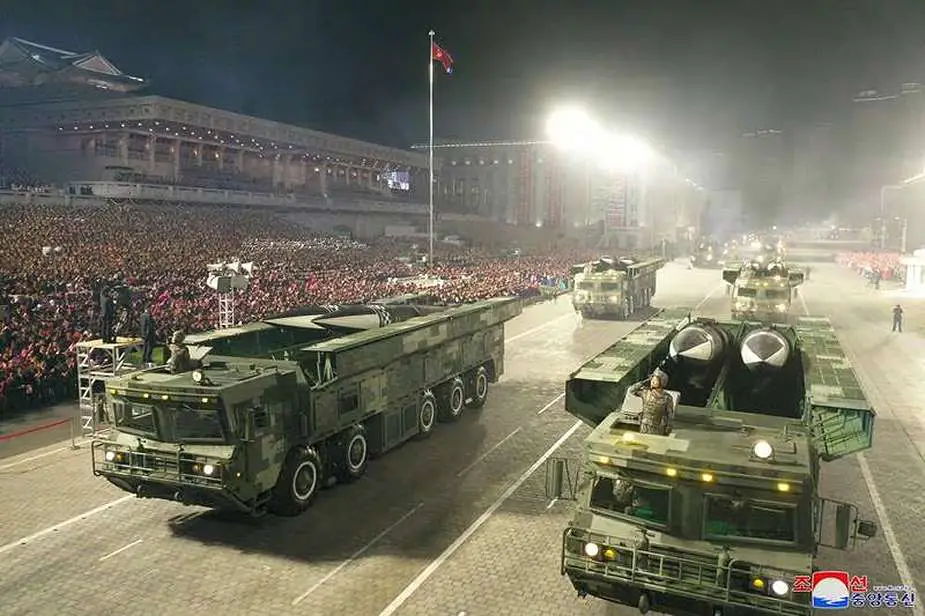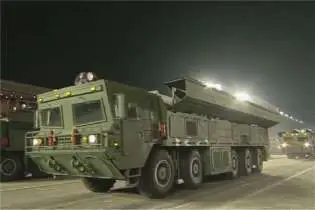- Army
- Air Defense Systems
- Anti-tank systems and vehicles
- Armored Vehicles
- Armoured personnel carriers
- Artillery Vehicles and Weapons
- Command Post
- Communication Vehicles and Systems
- Electronic Warfare
- Engineer | Maintenance Vehicles
- Infantry Fighting Vehicles
- Main Battle Tanks
- Missiles
- Tactical and Logistic Vehicles
- Radars
- Unmanned Systems
- Weapons
- Navy
- Air
KN-23 Hwasong-11Ga
KN-23 / Hwasong-11Ga
Short-range mobile tactical ballistic missile - North Korea

Description
The KN-23, first revealed during a North Korean military parade in 2018 and entering service around 2019-2020, is a short-range ballistic missile system that showcases significant advancements in the country's missile capabilities. Bearing conceptual similarities to the Russian Iskander and the South Korean Hyunmoo 2, it was developed with assistance from Russia and China. Initially, its operational status was uncertain, with the parade featuring six launcher vehicles equipped with two missiles each. The KN-23's official designation remains undisclosed, and the name KN-23 is used provisionally.
KN-23 ballistic missile variants:
- Hwasong-11Ga / Hwasong-11A
Description: Base model with a design similar to the Iskander missile.
Features: Standard configuration and specifications.
- Hwasong-11Da / Hwasong-11C
Description: An enlarged version of the original model.
Features: Capable of carrying a 2.5-ton warhead, offering increased payload capacity.
- Hwasong-11Ra / Hwasong-11D
Description: A smaller and more compact variant.
Features: Features a reduced range, likely for specific tactical applications.
- Hwasong-11S
Description: An underwater-launched version derived from the Hwasong-11A.
Features: Designed for submarine launch capabilities, enhancing stealth and versatility
Technical Data
| Launcher Vehicle |
|
The KN-23's launcher vehicle, initially presented in an 8x8 configuration, measures approximately 13 meters in length, 3.5 meters in width, and 3.5 meters in height, and weighs around 40 tons. It is operated by a crew of three and was initially capable of carrying two missiles. The design of this chassis, possibly originating from Belarus or China, shows notable differences from the Russian Iskander's MZKT-7930 chassis. In 2020, a new version with a tracked chassis was demonstrated, maintaining the dual-missile carrying capability.
|
| Missile |
|
The KN-23 missile is approximately 7.3 meters long with a diameter of 0.9 meters. It can carry a nuclear, chemical, or conventional warhead weighing around 500 kg. With a range of 600-700 km and a circular error probable (CEP) of 5 to 30 meters, the missile is notably accurate. This single-stage, solid-fuel missile surpasses the capabilities of North Korea's earlier KN-02 missile, which has a range of only 100-120 km.
|
| Mobility |
| The KN-23 launcher truck is powered by a diesel engine of around 500 horsepower, the KN-23 launcher vehicle can reach speeds up to 70 km/h and has an operational range of about 1,000 km. It demonstrates significant maneuverability, able to handle gradients of 45%, side slopes of 30%, vertical steps up to 0.6 meters, trenches up to 2 meters, and fording depths up to 1.4 meters. This mobility is crucial for the tactical deployment and repositioning of the missile system to evade detection and targeting. |
| Combat Use |
| The KN-23 is designed to challenge hostile air defense systems, capable of deviating from its initial flight trajectory, thereby complicating interception efforts. Its range and payload options make it a significant threat in the region, especially considering its capacity to reach all areas of South Korea. The introduction and enhancement of the KN-23 underscore North Korea's focus on advancing its strategic military capabilities and pose new challenges for missile defense strategies in the region. |
Specifications
| Type | Truck Armor |
| Mobile short-range tactical ballistic missile | No armor protection for the TEL (Transporter Erector Launcher) truck |
| Country users | Missile Weight |
| North Korea, Russia | 3,415 kg |
| Designer Country | Length Missile |
| North Korea | 9.8 m maximum |
| Warhead | Range Missile |
| 500 kg (1,100 lb), nuclear and conventional | - 450 km (280 mi) (initial version, standard payload) - 600 km (370 mi) (larger version, standard payload) |
| Engine | Guidance System |
| Solid composite propellant | Inertial navigation system (INS), possible satellite navigation |
Details View
 |
 |
 |
 |
Pictures - Video



























